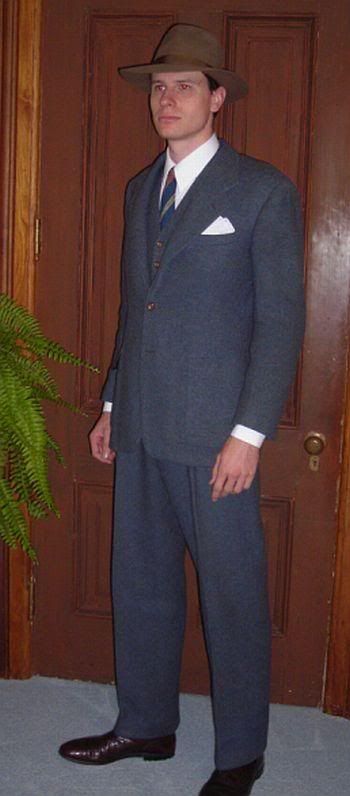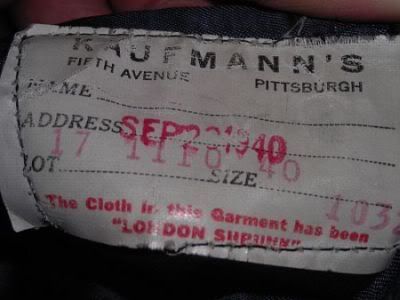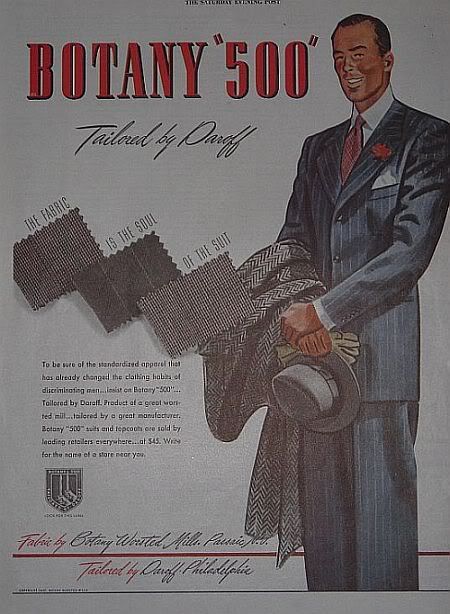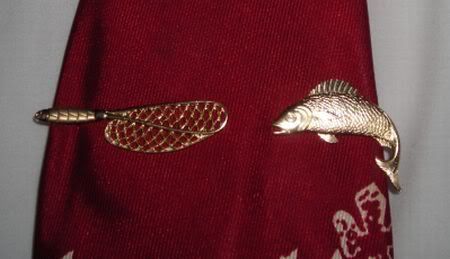
Thursday, October 30, 2008
Monday, October 27, 2008
WIW
Along with this suit I wore the following:
*1930s Mallory fedora
*1930s wool tie
*modern Van Heusen "fitted" shirt
*vintage watch chain with modern Union Pacific watch
*Allen Edmond shoes
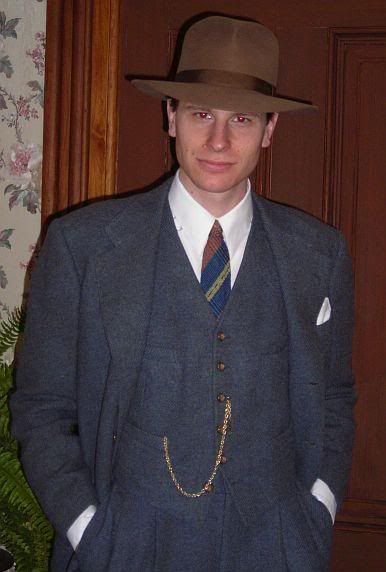
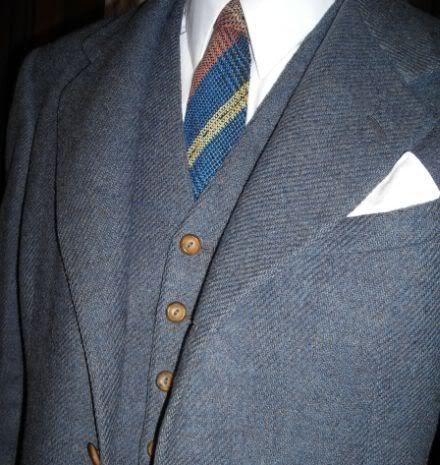
Friday, October 24, 2008
Sunday, October 19, 2008
What I Wore Today
*1940s Champ
*modern Halston 100% wool suit
*1950s(?) dacron tie
*late-1940s tie bar
*brown AE shoes
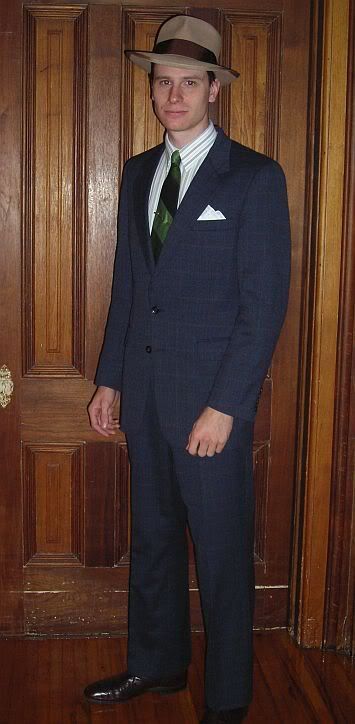
click to enlarge

What makes this look, in my opinion, is the tie. The wide stripes and funky colors speak of the Bold Look. It's an oddity, being 100% dacron polyester and while that might turn some people off let me assure you, dacron is not your father's polyester from the 1970s. That topic is for another post.
Wednesday, October 15, 2008
Firearms: the M-1 Garand
No matter what your political or philosophical view on firearms, I'm sure we all can appreciate the history and beauty of important rifles of the past, such as the WW2 American M-1 Garand (named after its inventor). In this post, we will give this rifle a quick look.
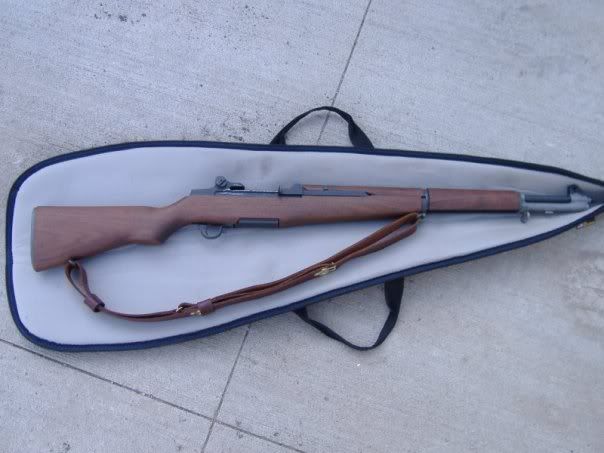 What you see above is the "the greatest battle implement ever devised" according to General Patton. And he may have been right.
What you see above is the "the greatest battle implement ever devised" according to General Patton. And he may have been right.
The M-1 Garand was so important during the Second World War because it was a semi-automatic in a war dominated by bolt-action rifles. It was the first semi-automatic battle rifle ever put into major use by a world power.
Bolt-action rifles like the German K98 Mauser, the British Lee Enfield, the Russian Mosin Nagant and the Japanese Type 99 needed to have the bolt manually operated before each round could be fired, giving soldiers decent firepower compared to weapons of the past. But next to the semi-automatic M-1, the bolt-action rifles could not compare. With the M-1, each pull of the trigger released one .30 caliber round without the bolt having to be operated manually. Not only that, but the internal magazine could hold 8 rounds before needing to be reloaded. This gave the American soldier a huge amount of firepower.
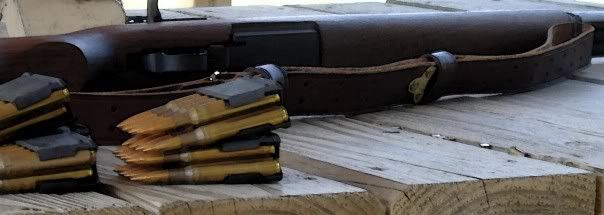 The stylized photo above shows the en-bloc clips that hold 8 rounds. These were inserted through the top of the reciever into the internal magazine.
The stylized photo above shows the en-bloc clips that hold 8 rounds. These were inserted through the top of the reciever into the internal magazine.
To do this the bolt was locked open. While the clip was inserted the bolt would unlock, stripping the first round off the clip. This unlocking, though, created a bit of a problem for the soldier. If the soldier did not get his thumb out of the way of the bolt, it would get slammed and pinched between the bolt and the reciever. This caused excruciating pain, swell the thumb and perhaps make the thumbnail fall off. This badge of honor was called "M-1 thumb" and was in a way a rite of passage. Anyone who 'earned' this experience quickly learned how to avoid it in the future.
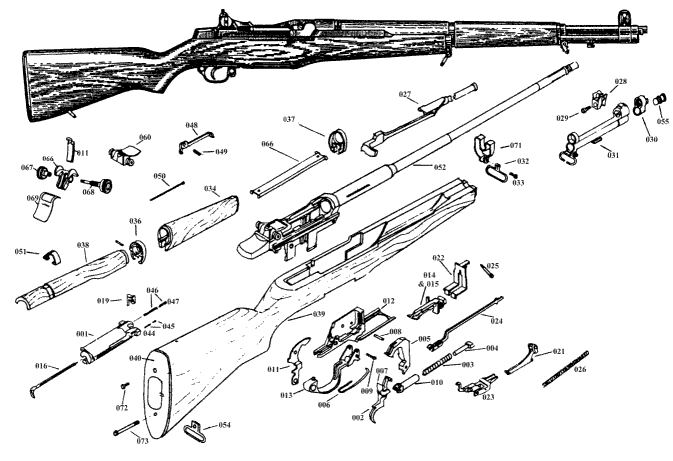 Disassembly of the M-1 is relatively easy, especially for a semi-automatic firearm. Field striping the M-1 is not difficult and can quickly be learned by the inexperienced shooter. The M-1 is a gas-operated rifle, meaning the expanding gas that propels the round down the barrel is siphoned to strike the face of the operating rod. This rod is driven back and pushes the bolt backward with it, resetting the hammer and trigger, ejecting the spent shell casing and allowing the bolt to strip off a fresh round on its return trip.
Disassembly of the M-1 is relatively easy, especially for a semi-automatic firearm. Field striping the M-1 is not difficult and can quickly be learned by the inexperienced shooter. The M-1 is a gas-operated rifle, meaning the expanding gas that propels the round down the barrel is siphoned to strike the face of the operating rod. This rod is driven back and pushes the bolt backward with it, resetting the hammer and trigger, ejecting the spent shell casing and allowing the bolt to strip off a fresh round on its return trip.Sunday, October 12, 2008
Style and Fashion, Male and Female
This does not mean a woman cannot look elegant while still being fashionable. However, for these two seemingly opposite things to coexist something must be considered: while elegance is informed by the past and fashion looks to the future, fashion must keep an eye on the past while two feet march into the future. If, infact, fashion has nothing tied to the past we end up with the newest fad that disappears within a year and is forgotten forever. Tradition is important for the fasionable.
Now we return to the style/fashion and male/female relationship. Just as a man and woman are each other's counterpart, style and fashion are inseparable. Say, for instance, a dashing couple entertain a party. The dress is formal, so men wear classic dinner jackets and women wear elegant dresses and fashionable accessories. The stylish male, being tied to the past, is the background for the fashionable female, who is to be the centerpiece of attention. Like a painting, the unchanging background scenery supports and surrounds the bright and stunning center of attention in the foreground. That is the place of the man and the place of the woman.
And while their tasks are so different, the stylish man and the fashionable woman are not opposites. Rather, they compliment one another and bring out the best points of the other's dress.
So males, be timeless and focus on classic style from the past. And females, be classic while also being forwardlooking. The man's job is easy: to be the background for the female. The woman's job is hard: to stand out while not being too loud. A simple and complimentary combiniation will always be successful.
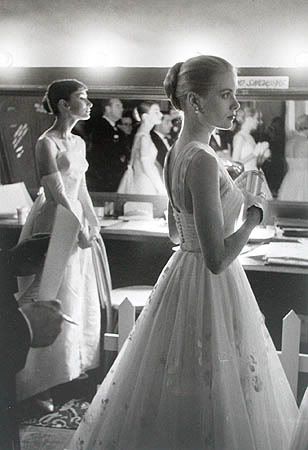
Wednesday, October 1, 2008
The Duke
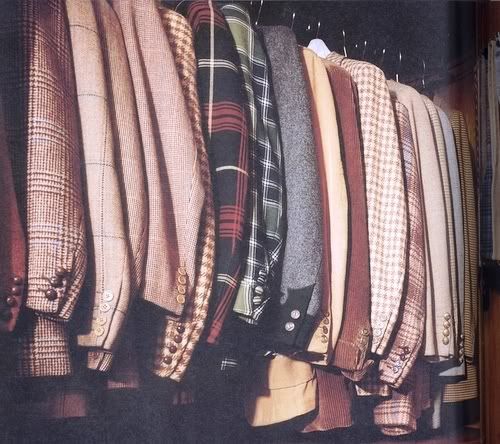
So, let's dig into the Duke's closet. The following photos are from Sotheby's catalog of the Duke's estate sale after his passing.
 The Duke's dressing room at the Paris residence with a suit in medium weight worsted with darker blue checking. The jacket is dated 16/11/56 by Scholte, London and the trousers dated 3/4/57 by Harris, New York. Jacket has side vents and substantially padded shoulders.
The Duke's dressing room at the Paris residence with a suit in medium weight worsted with darker blue checking. The jacket is dated 16/11/56 by Scholte, London and the trousers dated 3/4/57 by Harris, New York. Jacket has side vents and substantially padded shoulders. A double breasted navy wool suit with Grenadier (front buttons) and Welsh Guards Officer (sleeve buttons) buttons, worn on the 1936 Nahlin cruise. Jacket by Scholte, London labelled H.R.H. The Prince of Wales 25.4.31 Made of lightweight navy worsted. The matching pair of trousers were made by Forster & Son, London.
A double breasted navy wool suit with Grenadier (front buttons) and Welsh Guards Officer (sleeve buttons) buttons, worn on the 1936 Nahlin cruise. Jacket by Scholte, London labelled H.R.H. The Prince of Wales 25.4.31 Made of lightweight navy worsted. The matching pair of trousers were made by Forster & Son, London.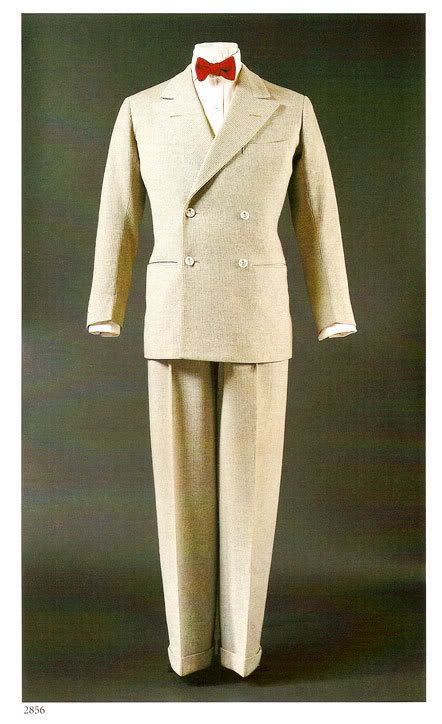 Grey and white ribbed suit with Royal Yacht Squadron buttons. Later inserted side vents. Jacket by Scholte, named and date 1938, and trousers by Forster & Son. The Duke was photographed in the USA in this suit in 1943.
Grey and white ribbed suit with Royal Yacht Squadron buttons. Later inserted side vents. Jacket by Scholte, named and date 1938, and trousers by Forster & Son. The Duke was photographed in the USA in this suit in 1943.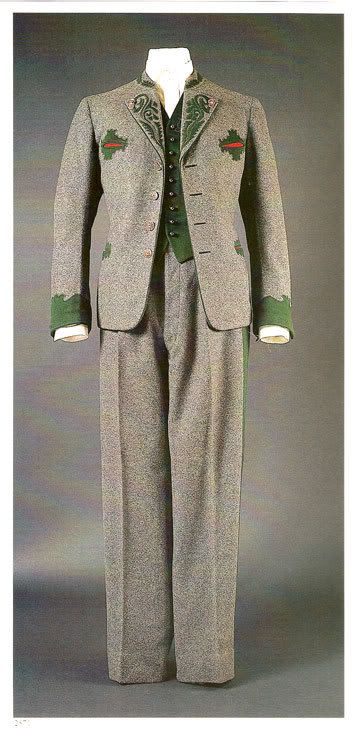 A Tyrolian suit by F. Humhal, Vienna. 1937. Grey Loden cloth with oak leaf appliqué, horn buttons and green piping to trouser side seams.
A Tyrolian suit by F. Humhal, Vienna. 1937. Grey Loden cloth with oak leaf appliqué, horn buttons and green piping to trouser side seams.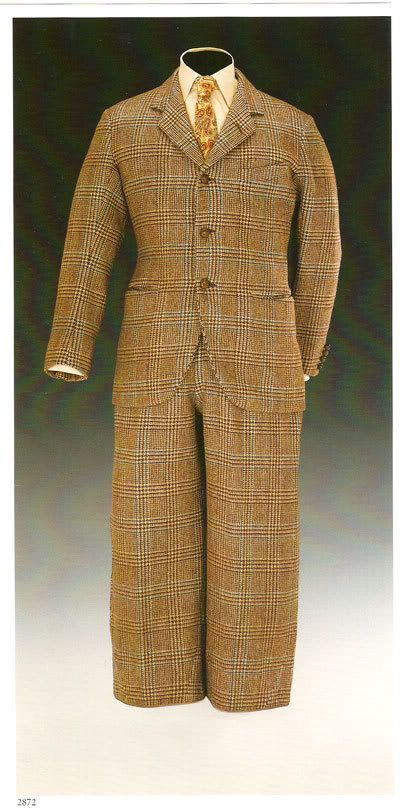 Prince of Wales check sports suit. Jacket by Scholte and stalking trousers (modified plus-fours) by Forster & Sons. 1923. Altered in the mid 1930s when a zip was inserted. Came with the removable blue cotton plus-four linings we've heard so much about (more on those below).
Prince of Wales check sports suit. Jacket by Scholte and stalking trousers (modified plus-fours) by Forster & Sons. 1923. Altered in the mid 1930s when a zip was inserted. Came with the removable blue cotton plus-four linings we've heard so much about (more on those below).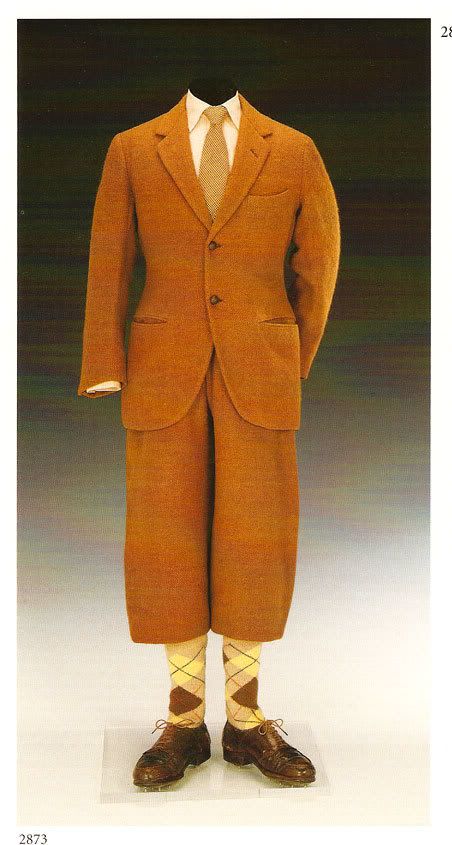 A rust Harris tweed golfing suit, 11.12.24. Jacket by Scholte, trousers by Forster & Sons. Jacket has a convertible collar for cold weather (I assume this means a button to which the lapel buttonhole fastens). Trousers "cut high in the waist and originally supported by an inner elasticated girdle to maintain a looser hang. The hems curve under to fasten to the cotton plus-four lining.
A rust Harris tweed golfing suit, 11.12.24. Jacket by Scholte, trousers by Forster & Sons. Jacket has a convertible collar for cold weather (I assume this means a button to which the lapel buttonhole fastens). Trousers "cut high in the waist and originally supported by an inner elasticated girdle to maintain a looser hang. The hems curve under to fasten to the cotton plus-four lining. Check tweed sport suit, and perhaps the greatest suit i've ever laid eyes upon, 1930. Again, the hip pockets would appear to be crescent.
Check tweed sport suit, and perhaps the greatest suit i've ever laid eyes upon, 1930. Again, the hip pockets would appear to be crescent.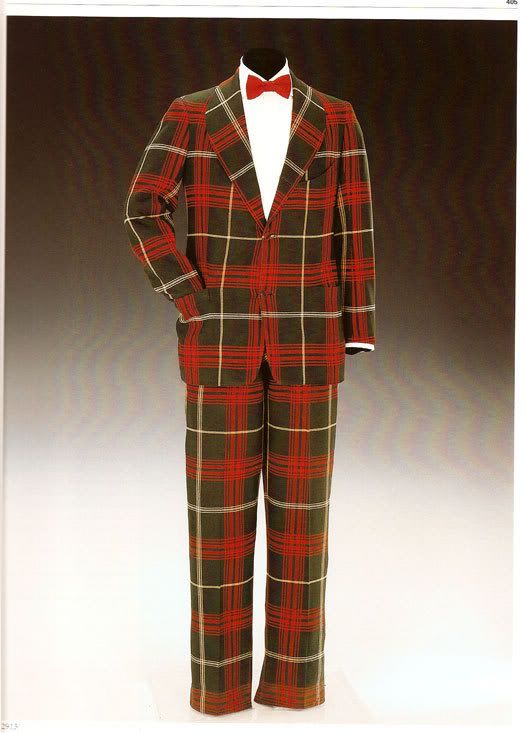 Rothesay Hunting tartan lounge suit with shaw collar. Made in 1897 apparently for his father, George V. re-tailored to fit DoW with a Talon zip added in place of the button fly. Apparently this suit triggered a vogue in tartan in the USA in the 50s.
Rothesay Hunting tartan lounge suit with shaw collar. Made in 1897 apparently for his father, George V. re-tailored to fit DoW with a Talon zip added in place of the button fly. Apparently this suit triggered a vogue in tartan in the USA in the 50s.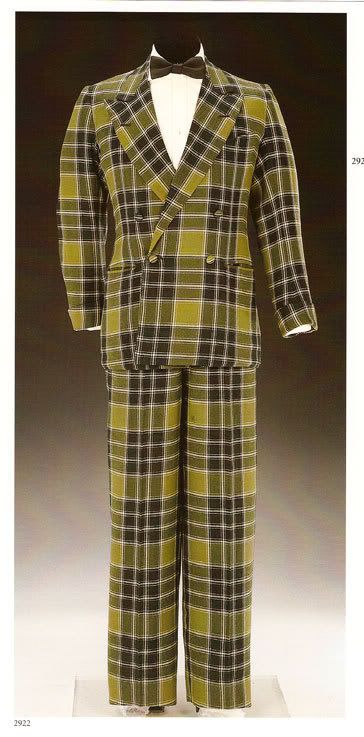 Hunting Lord of the Isles tartan evening suit. Jacket by Scholte dated 8.6.51, Trousers by Harris, New York. Jacket has side vents.
Hunting Lord of the Isles tartan evening suit. Jacket by Scholte dated 8.6.51, Trousers by Harris, New York. Jacket has side vents. 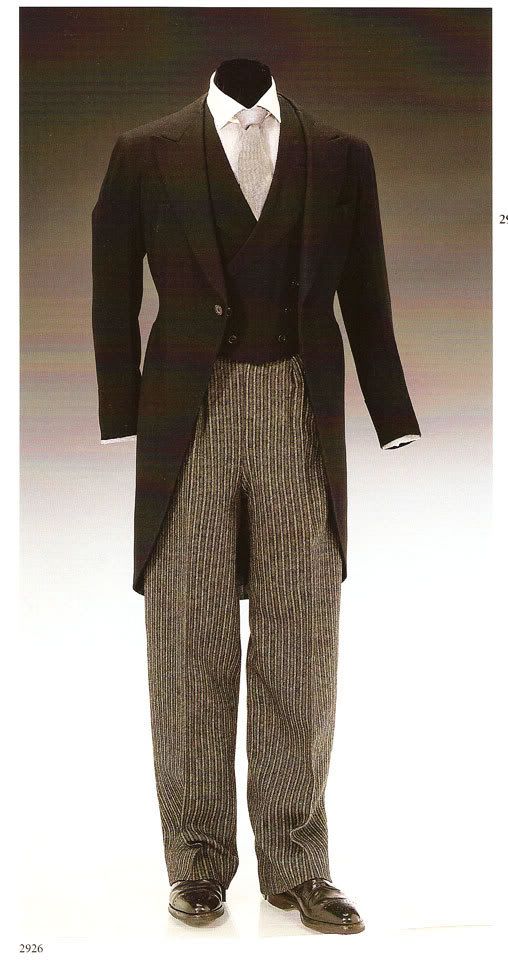 The morning coat and trousers worn to his wedding, with a different waistcoat. Jacket by Scholte is a herringbone cashmere weave and is marked H.M. The King, 25.1.36. Waistcoat matches the jacket and marked same. The morning trousers are by Forster & Son and marked 9.6.32 This was bought by the CEO of Kiton for $27,600.
The morning coat and trousers worn to his wedding, with a different waistcoat. Jacket by Scholte is a herringbone cashmere weave and is marked H.M. The King, 25.1.36. Waistcoat matches the jacket and marked same. The morning trousers are by Forster & Son and marked 9.6.32 This was bought by the CEO of Kiton for $27,600.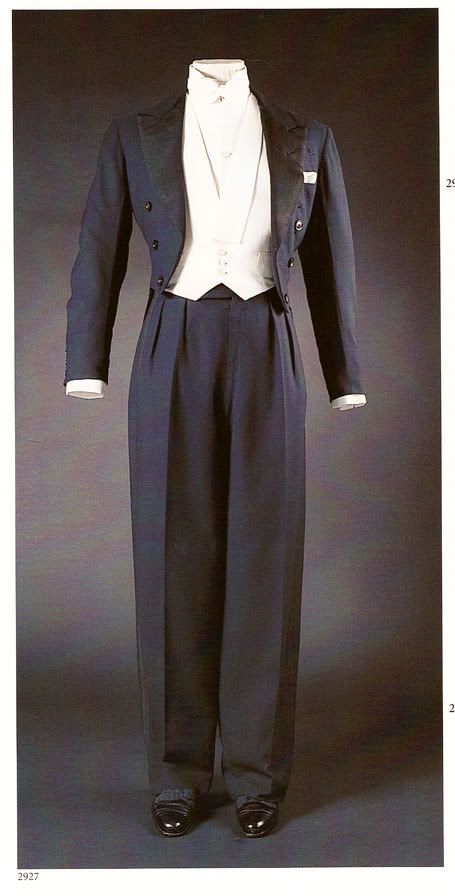 A midnight blue worsted formal evening dress suit, 1937. Jacket probably Scholte, trousers by Forster & Son
A midnight blue worsted formal evening dress suit, 1937. Jacket probably Scholte, trousers by Forster & Son 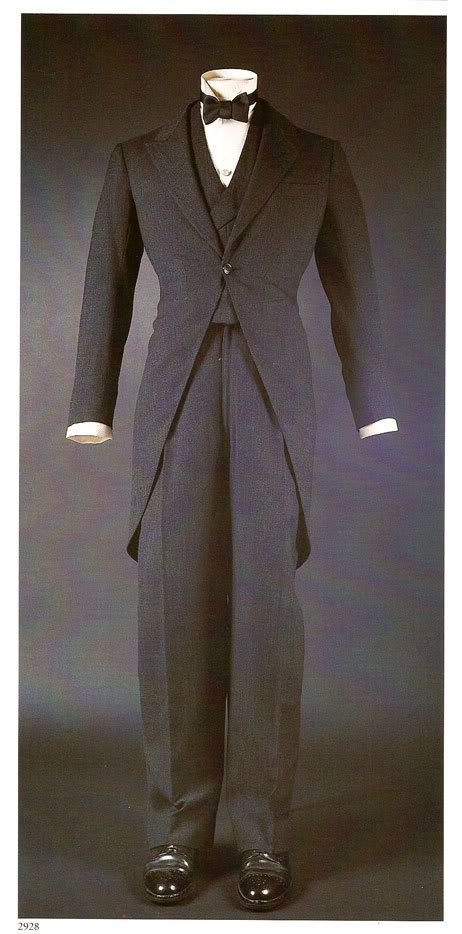 A dark grey worsted 3-piece morning suit. Jacket and DB waistcoat by Scholte, marked 9.6.31 Trousers by Forster & Son marked 10.6.31
A dark grey worsted 3-piece morning suit. Jacket and DB waistcoat by Scholte, marked 9.6.31 Trousers by Forster & Son marked 10.6.31  A dark green double-breasted corduroy shawl-collared dinner jacket with Beaufort Hunt buttons. by Scholte, dated 12.10.59 and a pair of H. Harris, New York, trousers in navy herringbone wool and cashmere marked 1.2.56
A dark green double-breasted corduroy shawl-collared dinner jacket with Beaufort Hunt buttons. by Scholte, dated 12.10.59 and a pair of H. Harris, New York, trousers in navy herringbone wool and cashmere marked 1.2.56  A beige and Brown houndstooth check suit, 1932. Jacket by Scholte has side vents. Trousers by Forster & Son. (For some reason, the photo was reversed.)
A beige and Brown houndstooth check suit, 1932. Jacket by Scholte has side vents. Trousers by Forster & Son. (For some reason, the photo was reversed.) Two aluminium wallets with town clothes, and one for sports clothes. Inside are paper sheets with swatches of fabric attached. Hand written notes say where each garment is located (NYC, Paris, The Mill (French country retreat)). From the catalogue blurb: "It serves as a very interesting and useful record of his entire wardrobe around 1960 . . . The swatch boxes show that he owned approximately 15 evening suits (of which six remain), over fifty-five lounge suits, of which thirty would have been kept in Paris. Only six or so remain of these, and only five of them relate directly to the swatch boxes. The majority of the formal and Highland dress detailed in the swatch boxes still remains in the collection as the Duke kept most of his formal wear in Paris and his Highland dress at The Mill, where he was fond of wearing it in the evening." This seems to me to be an excellent idea for someone who has multiple residences and a massive wardrobe.
Two aluminium wallets with town clothes, and one for sports clothes. Inside are paper sheets with swatches of fabric attached. Hand written notes say where each garment is located (NYC, Paris, The Mill (French country retreat)). From the catalogue blurb: "It serves as a very interesting and useful record of his entire wardrobe around 1960 . . . The swatch boxes show that he owned approximately 15 evening suits (of which six remain), over fifty-five lounge suits, of which thirty would have been kept in Paris. Only six or so remain of these, and only five of them relate directly to the swatch boxes. The majority of the formal and Highland dress detailed in the swatch boxes still remains in the collection as the Duke kept most of his formal wear in Paris and his Highland dress at The Mill, where he was fond of wearing it in the evening." This seems to me to be an excellent idea for someone who has multiple residences and a massive wardrobe.